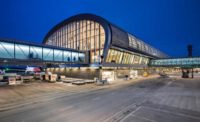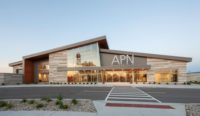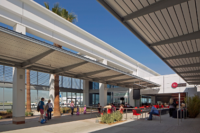Logan Airport Terminal Update, Expansion Utilizes ACM

Photo courtesy of Alucoil North America.
The goal of the Logan Airport Terminal E modernization was to “create a sustainable, high-performance, resilient and resource efficient building that is a comfortable and healthy environment for passengers and workers alike.”
Completion of Boston’s newest eye-catching facility, including the installation of aluminum composite material (ACM), larson® by Alucoil, took more than four years. Modernizing the facilities included the addition of four new gates, including three approved in 1995 but never built.
“The project required 400,000 square feet of 4mm FR Core larson by Alucoil, which we fabricated into a rainscreen system,” says Dan Nadeau, vice president – preconstruction at LYMO Construction Co. of Londonderry, N.H. “The design criteria was very specific on all aspects of the ACM’s performance, color, finish, paint application and fabrication tolerances. The specification called for a prismatic (color shifting) paint system with multiple gloss levels to achieve the iconic design.”
Nadeau says each component of the wall assembly – metal studs, thermally broken cladding supports and rainscreen system – needed to be installed in the exact X, Y, Z position in order to maintain the surface geometry. That requires a full-time team of onsite surveyors and engineers to support the installation crews.
“The design team’s vision to create an ‘orb’ using an architectural metal was the biggest challenge,” Nadeau says. “Maintaining a surface with a geometry this complex required a year of collaboration and innovation. Rather than engineering rainscreen panels for fabrication using traditional methods like CAD, innovative softwares like Rhino and Grasshopper were used to ‘script’ the final panel layout to ensure the final orb surface geometry was achieved. Each component of the wall assembly was embedded with X, Y, Z coordinates tied into the project’s site control.”
Grason Cook, Commercial Director of Alucoil North America, says design teams from both Europe and the United States collaborated on the Terminal E project. “It takes a manufacturer like ours with a global reach and sales people on the ground to coordinate a project like this,” Cook says. “The specified paints were from Monopol in Switzerland and coated at Euramax in the Netherlands with panel production out of South Carolina. It was an undertaking to ensure communication was flowing properly.”
The specialty paints used for the façade were also used for the roofing elements.
Customers will notice roughly 320,000 square feet of additional space and renovations including four new aircraft gates, comfortable waiting areas at those new gates, new local and internationally inspired food and retail options, and glass that provides shade from sun glares. According to the Massachusetts Port Authority website, sustainability initiatives include the lowering of energy usage and greenhouse gas emissions, water conservation, additional waste management and recycling, air quality improvement and reduced energy consumption.
“The finished product absolutely achieved the goal of being the new icon at Logan International,” Nadeau says. “The surface geometry, color, gloss and design all make a dramatic statement. We couldn’t be happier with the outcome. It could not have been done without commitment, collaboration and new innovations.”
Looking for a reprint of this article?
From high-res PDFs to custom plaques, order your copy today!





